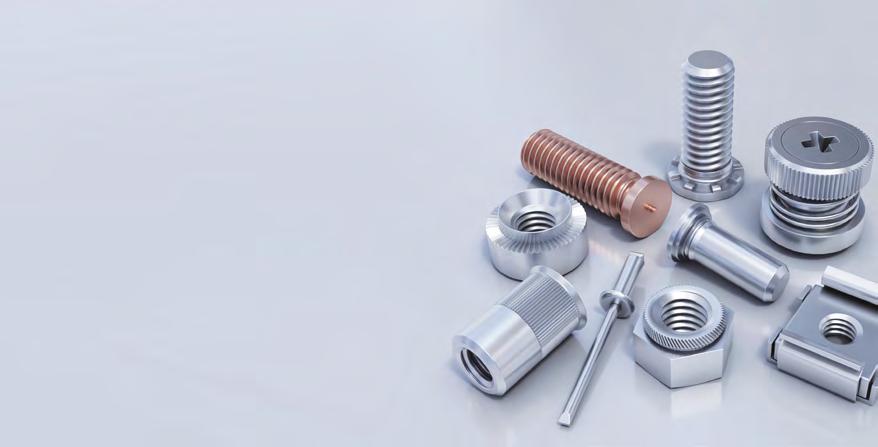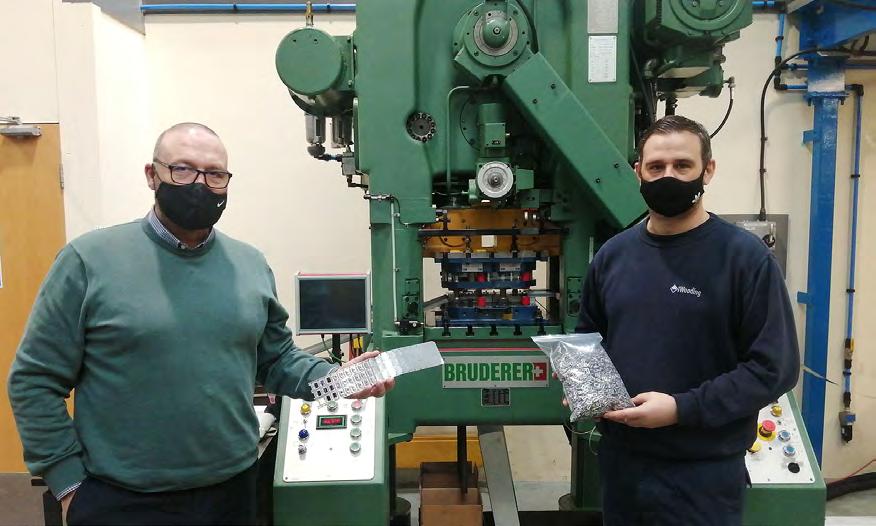
13 minute read
Sheet Metal Forming Tools
from ISME Spring 2021
John Yarnall
Part 2b of series 2
Advertisement
Advanced Surface Coatings & Treatments For Protecting Tools Against Wear In Service.
I am delighted to present this second instalment on tool coatings as part of ISME’s75th anniversary year. Throughout these years 1946 to 2021, tools have always played a fundamental role in high volume manufacture of sheet metal parts. New CAD and metal simulation software has made possible considerable advances in design to make possible new part shape geometries for automotive and general engineering applications. It is also now recognised that without the advances in press forming equipment with integrated tool design features, these startling developments would not have happened. And now with the new world of digital engineering and manufacture, we can expect to see further striking advances in sheet metal forming technology. There are many more challenges on the horizon for our industry as the range of materials being selected for weight reduction is on the increase. High strength with low weight is now the new mantra for automotive and aerospace designers for their mission to further reduced energy and environmental impact of their products. To achieve their goals a new set of materials is now fi rmly on their agenda too. The start of this new criteria is now already with us, in the form of micro-alloyed high yield strength steels, high strength aluminium alloy grades, and an advanced set of high temperature and corrosion resistant Nickel/Chromium grades such as stainless steels and Inconel. Tooling materials and coatings are of necessity to enable these new materials to be formed economically. So to help meet these challenges of ever complex forming geometries with increased reliance on ‘zero defect’ high speed forming production, tools have to take the burden. A new generation of tool materials and coatings in combination with metal forming lubricants will need to be the choice of most sheet metal formers to ensure that the economics of their business process keep pace with demand for their high value/high quality products. As an example: existing high volume food and beverage can manufacture would not be possible without these three technologies: advanced tool materials, process lubrication, tool surface coatings and treatments. As a further illustration to give a historical perspective, press tools used during the periods WW1 &WW2 and up to the 1970’s for stamping and deep drawing, tools were generally made from lower alloy tools steels of grade B O1 or BD series hardened & tempered only, but then latterly, nitride surface hardened in combination with process lubrication were the main enabling technology to assist volume manufacture. Today, advanced HIPIMS PVD coating/duplex treatments is the preferred tool surface protection for many metal sheet forming applications. So the technology conditions of the 1940’s in contrast to those 75 years on has a seismic improvement in tooling technology. These improvements have made possible a transformation in the capability of practice and science of sheet metal forming. I have tried to focus, as space permits, on two or three state-of-the-art forming and stamping technologies. The theme being: tooling, lubrication; surface coating, including work stock material and metallurgical heat treatment using vacuum and plasma techniques. To illustrate how sheet forming has developed to the level of 2021viz tool coatings, lubrication (no specifi c detail on process lubrication will be referenced in the instalment, this will be featured in a later issue) and metallurgical treatments. The following examples should serve to demonstrate how the industry has moved forward to meet the advanced needs of market demands, sustainability and economics. Some case histories and interesting examples of sheet metal applications of tooling used to produce quality parts for the food, beverage, and automotive markets.
Surface fi nishing of tools pre & post coating… as an illustration: steel & aluminium food & beverage packaging can tools.
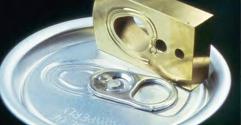
Fig 4. The TiN PVD coating on this soda tab punch helps to prevent material pickup and premature tool wear. This shows a typical application of the use of tools with coatings for forming of aluminium, easy-open food and beverage cans. The use of metal based food containers is now a preferred route instead of polymer based to reduce environmental impact. This illustration shows one of the coated tooling elements used to deliver high volume production… Aluminium grade 1050-H24, canning light weight recyclable specifi cation. Tool steel: cold work grade D-series powder metallurgical, with a PVD top layer PVD nitride family with optimised food approved composition.
Surface Preparation.
Surface preparation is critical in any tooling application, and especially in stamping applications. Any marks on the surface of a stamping tool will work as a nucleation site for adhesive wear. The workpiece material will fl ow into the microscopic imperfections on the tool surface and stay there. During further forming operations, more material will build up on these areas, causing galling. Galling is a common problem in metal forming and stamping operations. It results in increased roughness on the part resulting in premature tool wear. Therefore, improving the fi nish of the working surfaces is a very important part of the tool preparation. The recommended surface fi nish is 8 micro inches or more; a high polish, if possible, often is best. After polishing, the tool must be inspected for surface quality. If machining or grinding marks are still visible, then the die needs to be re-polished. Stoning before polishing will produce a uniform surface. It is extremely important that the last polishing steps be performed in the direction of the metal fl ow. Beverage and food can manufacture. The example in fi g 4, illustrates this where boundary lubricant cannot fully provide separation of workpiece and tool during ultra-high surface stress patterns; that is where the sticking and abrasion problems are the most prevalent mode of tool surface failure. So in these examples tools are coated with low friction ceramic PVD coatings which have been produced using High Impulse Magnetron Sputtering (HIPIMS) method to provide hard smooth thin fi lm coating which exactly follows the working tool surface to ensure surface wear protection at high contact stress forming. For sustained production rate throughput, digital manufacturing can now be used to monitor process control and part quality. In the second case illustrated below for food can manufacture, tools are coated with multilayer chemical vapour deposition (CVD) coating: Titanium Carbide/Titanium Carbonitride/ Titanium Nitride (TiC, TiCN, TiN). It should be noted, however, that the choice of coating and coating method depends very much on the work stock sheet material, and the grade of tool steel used for the tools. Heat treatment using vacuum furnaces for hardening tools also plays a vital role in the success of tool surface wear protection…
Figs 4 a, b, c of beverage cans, CVD a Coated WC tooling and aluminium coil sheet for producing food and Beverage Containers (Cans) Seaming Rolls Chemical Vapour Deposition coated with 8µ thick layers of TiC/TiCN/TiN
Finished packaging food cans after high volume seam forming. The size and surface fi nish of the corrugated can form is controlled by the tool coating by maintaining the surface integrity of the tool during high volume manufacture.

Example of tool coatings for advanced sheet forming of aluminium (Automotive)
The application of aluminium alloys in automotive and aerospace industries has been growing signifi cantly in the last 20 years. Due to their high specifi c strength, aluminium became a strong alternative for steel particularly at automotive manufacturing. However, to deform a complex panel part from aluminium is quite challenging especially at ambient forming condition in which the formability index is relatively quite low. Many attempts have been made to improve the formability of the aluminium alloy such warm forming, hot forming, superplastic forming and Hot Form Quenching (HFQ) processes. HFQ presents the best practical and proven way forward. There are many advantages and still some drawbacks for this method, but if forming in the correct T4 solution treated condition (SHT) and post T6 cold form to fi nal size hot assisted forming is the better route due to formability limitations of, say, 6xxx Al- grades. HFQ has now been commercialised and taking full advantage of ‘low spring-back’ forming challenges with ever increasing demand by automotive and aerospace industry. There are other familiar forming technologies in use and still being developed (Superplastic and Isothermal forming etc.). Signifi cant further benefi ts can be gained using tools super fi nish coated with ultra- hard low friction surfaces to both aid uniform metal fl ow and provide anti-galling/wear surfaces. Tool coatings play a crucial role in the effi ciency and process economics of the forming process. So HFQ technology with aided PVD chromium nitride coated tools is now being used in Europe for 6xxx Al-alloy series sheet to achieve uniform metal distribution and mechanical properties via the tooling system is now regular use for producing automotive body panel parts. As previously discussed, tool coatings used for aluminium forming tools can help further optimize the forming process and to increase the working life of the tooling system. The main properties required are the reduction of surface friction and reduction of both abrasive/adhesive wear. Furthermore, the bonding strength of the coating to the tool surface must be high to prevent detachment of the coating. Thin fi lm Diamond like Coatings (DLCs) has shown good results when forming aluminium. However, tools should be cooled to keep an optimum die temperature not to exceed 200 DegC. Typical DLCs WC/C PVD deposited show good results and excellent performance can be further achieved combination of PVD Chromium Nitride tool coating and/or with thermochemical plasma nitriding used as a support substrate when tool interfacial stresses are high. However, it must be stated that PVD CrN or Thermochemical plasma nitriding is only effective for this process if BDH series tool steels hardened & tempered is used, or similar steel with a tempering temperature in excess of 500 DegC. Surface Quench heat transfer must fi rst be assessed to take account of the ‘part quench index’.
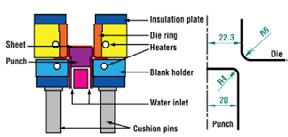
Fig 5 a & b: Schematic arrangement of tool steel and Hot Forming of Al-heat treatment heat treatment graphic. Fig 6: Hot Form Quench Process to achieve complex formed shape and optimised metallurgical properties with zero spring back in most cases. Condition of the part after age hardening… see illustration graph below. And distortion/spring back b & c.
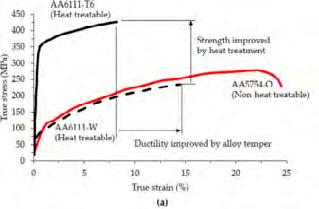
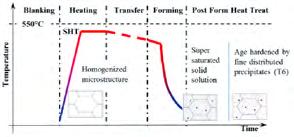

Challenges of aluminium and steel: sticking & abrasive wear.
Sticking. There are two primary challenges with forming aluminium alloys. The fi rst is sticking of the aluminium to the surface of the tool. Sticking of aluminium looks similar to galling of steel, but the mechanism that creates the sticking is different. When steel material picks up on or galls the surface of a tool, it is the result of dynamic friction between the two surfaces. The level of galling can be managed by minimizing the amount of dynamic friction present. Aluminium sticks to the surface of tooling when it is being formed because of localized melting of the material caused by the heat generated during plastic deformation. To prevent the aluminium from sticking, an effective boundary lubricant that stays in place when the die closes and pressure is exerted must be present. Alternatively, a tool coating that exhibits excellent static friction properties must be applied. Traditional ceramic coatings like titanium nitride (TiN), titanium carbonitride (TiCN), titanium aluminium nitride (TiAlN), and chromium nitride (CrN) do not provide enough static friction resistance, so their use without an effective boundary lubricant will result in substantial aluminium sticking. Abrasion.in addition to sticking of aluminium alloys—particularly so-called military-grade materials—bring challenges. Abrasion most likely results from two sources: the presence of aluminium oxide on the surface, and the silicon contained in the alloy to strengthen it. Silicon’s abrasiveness is of particular concern in tool functions that are working through the cross section of the material. The industry is taking steps to address the sticking problem by using effective boundary lubrication on the draw stations. In secondary stations such as trimming, piercing it serves supplemental role with tool coatings. An example of this is in forming operations such as tube forming.
Tool coatings for Stamping & Flow Forming of aluminium alloys:
As there is a forward need to support ever lighter and energy effi cient sheet engineering structures, aluminium and is sister light alloys are gaining more importance in automotive and aerospace part supply. In particular, electric vehicles (EV’s) and aero propulsion systems are pushing the limits of materials development to achieve lower cost transport systems. There are other important drivers which are now entering the manufacturing and materials cycle such as sustainable manufacturing and environmental ‘net gain’ goals. Tool coatings are playing a signifi cant role in helping to achieve these aims by using sophisticated coating technologies such as PVD DLC and its other family of metal carbides and nitrides with duplex properties to withstand/reduce higher friction forces between tool and work stock sheet. Aluminium alloys for aerospace and automotive body structures are a prime example… The examples below illustrates the range of advanced industrialised tool coatings that are now readily available for sheet metal stamping and fl ow forming:
Carbon Coatings - Application illustration of multi-layer:
Fig 7. forming tools DLC family composite Top section tool, Chromium Nitride (CrN) + DLC, Bottom section tool, Tungsten Carbon
For aluminium applications in which sticking and abrasion occur, “diamond-like” carbon (DLC) coatings have been developed to provide protection that traditional ceramic PVD CrN coatings cannot. DLC is the name given to a family of coatings produced either by PVD or plasmaassisted chemical vapour deposition (PACVD) processes that can exhibit a range of properties. However, these very hard coatings often lack the ductility required for some forming tool applications except in low stress forming of unalloyed light metals where high adhesive wear metal transfer is to be avoided. The value of DLC coatings lies in their low coeffi cient of friction and their anti-sticking properties. The most commonly used DLC coatings are multi-layered.
New development thin fi lm coatings:
Because of the demand for high duty performance tools with lower surface friction with antiwear properties at room, or elevated service temperatures, a new family of commercial coatings has been developed. This new family comprises several designed to cater for forming a range of sheet materials from steels through to aluminium automotive grades. Moreover, there are signifi cant challenges in the forming of both sheet and bulk Ni/Cr alloys (Inconel trade name). The chemistry of these advanced coatings is based on superlattice structured TiAlCrN/TiAlYN and CrAlYN/CrN thin fi lm layers (up to 4µm thickness). This family is currently referred by its generic chemical formulae. There will be a commercial product name given this family in the near future. It is now commercially possible to deposit these coatings on to hardened tool steel dies as well as tungsten carbide materials. Development work is now being under taken by IHI IonBond Group in the UK who now offers a combination of ‘Duplex layer ‘tool coating system using plasma nitriding as a base substrate case hardened layer. First indications are that these duplex systems are very stable and provide wear protection up to 1000 DegC. Further details can be obtained via NHTC, Sheffi eld Hallam University, and IonBond UK.
References:
A full version this article can be found via ISME website: isme.org.uk, & LinkedIn
www.linkedin.com/institute-of-sheetmetal-engineering.
John Yarnall
EUR ING John Yarnall CEng, CEnv, MISME, FIMMM / ISME Media & Surface Innovations Consultancy, UK

